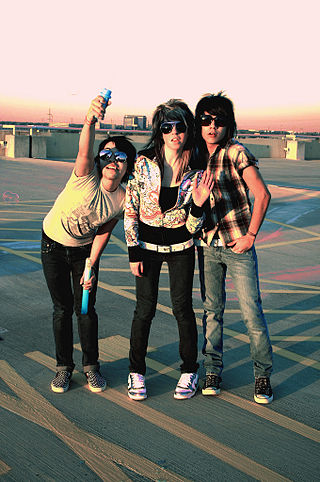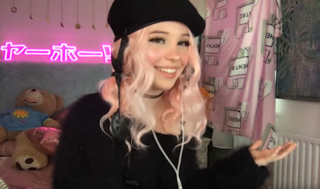Emo is a music genre characterized by emotional, often confessional lyrics. It emerged as a style of hardcore punk and post-hardcore from the mid-1980s Washington, D.C. hardcore scene, where it was known as emotional hardcore or emocore. The bands Rites of Spring and Embrace, among others, pioneered the genre. In the early-to-mid 1990s, emo was adopted and reinvented by alternative rock, indie rock, punk rock, and pop-punk bands, including Sunny Day Real Estate, Jawbreaker, Cap'n Jazz, and Jimmy Eat World. By the mid-1990s, Braid, the Promise Ring, and the Get Up Kids emerged from Midwest emo, and several independent record labels began to specialize in the genre. Meanwhile, screamo, a more aggressive style of emo using screamed vocals, also emerged, pioneered by the San Diego bands Heroin and Antioch Arrow. Screamo achieved mainstream success in the 2000s with bands like Hawthorne Heights, Silverstein, Story of the Year, Thursday, the Used, and Underoath.
Teen pop is a subgenre of pop music that is created, marketed and oriented towards preteens and teenagers. Often, the artists themselves are teenagers during their breakout. While it can involve influences from a wide array of musical genres, it remains a subset of commercial pop, focusing on catchy melodies and marketability. Teen pop’s lyrics emphasize themes that teenagers can relate to, such as love, growing up, or partying. The image of the artist as an aspirational or desirable teenage figure is a crucial element of the genre, highlighting their visual appeal.
The 20th century saw the rise and fall of many subcultures.

The Teddy Boys or Teds were a mainly British youth subculture of the early 1950s to mid-1960s who were interested in rock and roll and R&B music, wearing clothes partly inspired by the styles worn by dandies in the Edwardian period, which Savile Row tailors had attempted to re-introduce in Britain after the Second World War.
Gyarupronounced[ɡʲa̠ꜜɾɯ̟ᵝ], is a Japanese fashion subculture. The term gyaru is a Japanese transliteration of the English slang word gal. The initial meaning as a Japanese slang word during the Showa era was similar to the English meaning and referred to a young woman in her late teens to twenties. In the early Showa period, the term Gyaru was also used in a mocking manner towards young women with a "frivolous" lifestyle.
Japanese street fashion refers to a number of styles of contemporary modern clothing in Japan. Created from a mix of both local and foreign fashion brands, Japanese street fashions tend to have their own distinctive style, with some considered to be extreme and imaginations, with similarities to the haute couture styles seen on European catwalks.

The fashion of the 2000's is often described as a global mash up, where trends saw the fusion of vintage styles, global and ethnic clothing, as well as the fashions of numerous music-based subcultures. Hip-hop fashion generally was the most popular among young people of both sexes, followed by the retro inspired indie look later in the decade.

A scrunchie is a fabric-covered elastic hair tie used to fasten medium to long hair types. The elastic hair tie is encased in loose fabric that forms a ruffle when twisted around a ponytail. Large, elaborate styles and diminutive, unassuming forms are available in many different colors, fabrics, and designs.

The scene subculture is a youth subculture that emerged during the early 2000s in the United States from the pre-existing emo subculture. The subculture became popular with adolescents from the mid 2000s to the early 2010s. Members of the scene subculture are referred to as scene kids, trendies, or scenesters. Scene fashion consists of skinny jeans, bright-colored clothing, a signature hairstyle consisting of straight, flat hair with long fringes covering the forehead, and bright-colored hair dye. Music genres associated with the scene subculture include metalcore, crunkcore, deathcore, electronic music, and pop punk.

The 2010s were defined by hipster fashion, athleisure, a revival of austerity-era period pieces and alternative fashions, swag-inspired outfits, 1980s-style neon streetwear, and unisex 1990s-style elements influenced by grunge and skater fashions. The later years of the decade witnessed the growing importance in the western world of social media influencers paid to promote fast fashion brands on Pinterest and Instagram.
A kidult is an adult whose interests or media consumption is traditionally seen as more suitable for children. It can also mean a parent who acts childish with their children, but does not take on their duties as a disciplinarian.

Soft grunge was a fashion trend that originated on Tumblr around the late 2000s and early 2010s. Beginning as an outgrowth of the 2000s indie sleaze fashion trend but with a greater influence from the 1990s, particularly grunge fashion, the style began as a reaction against the glamor fitness culture which was dominant in popular culture at the time. It is characterized by its merger of cute and aggressive fashion hallmarks like chokers, tennis skirts, leather jackets and boots, flower crowns, distressed denim and pastel colors. Soft grunge reached its peak popularity around 2014, by which time it had been embraced by high fashion designers including Hedi Slimane and Jeremy Scott and been worn by celebrities including Charli XCX. Its internet-based merger of subculture, fashion and music made it one of the earliest examples of an internet aesthetic. In the early 2020s, the style experienced a minor resurgence due to videos posted on the video sharing application TikTok.

Mary-Belle Kirschner, better known as Belle Delphine, is a South African-born British media personality, pornographic actress, model, and YouTuber. Her social media accounts feature erotic and cosplay modelling, sometimes blending the two together. Her online persona began in 2018 through her cosplay modeling on Instagram. Her posts on the platform were often influenced by popular memes and trends.
Cole Chase Hudson, known professionally as Huddy, is an American singer, actor, and social media personality, known for co-founding the TikTok collective the Hype House, and popularizing the e-boy fashion style and subculture. A 2020 article in Billboard Magazine rated him as one of the top 10 music influencers on TikTok that year, with over 30 million followers, and one of the most influential people on the platform. He has also been cited by Paper as an important figure in the 2020s pop punk revival.

Dark academia is an internet aesthetic and subculture concerned with higher education, the arts, and literature, or an idealised version thereof. The aesthetic centres on traditional educational clothing, interior design, activities such as writing and poetry, ancient art, and classic literature, as well as classical Greek and Collegiate Gothic architecture. The trend emerged on social media site Tumblr in 2015, before being popularised by adolescents and young adults in the late 2010s and early 2020s, particularly during the COVID-19 pandemic.

The fashions of the 2020s represent a departure from 2010s fashion and feature a nostalgia for older aesthetics. They have been largely inspired by styles of the late 1990s to mid-2000s, 1980s, and late 1960s to early 1970s Early in the decade, several publications noted the shortened trend and nostalgia cycle in 2020s fashion. Fashion was also shaped by the COVID-19 pandemic, which had a major impact on the fashion industry, and led to shifting retail and consumer trends.

Mall goths are a subculture that began in the late-1990s in the United States. Originating as a pejorative to describe people who dressed goth for the fashion rather than culture, it eventually developed its own culture based around nu metal, industrial metal, emo and the Hot Topic store chain. It has variously been described as a part of the goth subculture, as well as a separate subculture simply influenced by goth.
Soft Girl or Softie describes a youth subculture that emerged among female teenagers around mid-to late-2019. Soft girl is a fashion style and a lifestyle, popular among some young women on social media, based on a deliberately cutesy, feminine look with a "girly girl" attitude. Being a soft girl also may involve a tender, sweet, and sensitive personality.
An Internet aesthetic, also simply referred to as an aesthetic or microaesthetic, is a visual art style, sometimes accompanied by a fashion style, subculture, or music genre, that usually originates from the Internet or is popularized on it. Throughout the 2010s and 2020s, online aesthetics gained increasing popularity, specifically on social media platforms such as Tumblr, Pinterest, Instagram, and TikTok, and often were used by people to express their individuality and creativity. They can also be used to create a sense of community and belonging among people who share the same interests. The term aesthetic has been described as being "totally divorced from its academic origins", and is commonly used as an adjective.











